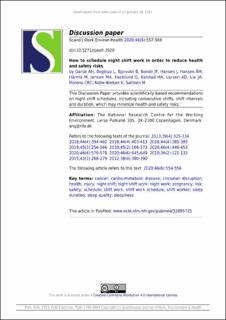| dc.contributor.author | Garde, Anne Helene | |
| dc.contributor.author | Begtrup, Luise | |
| dc.contributor.author | Bjorvatn, Bjørn | |
| dc.contributor.author | Bonde, Jens Peter | |
| dc.contributor.author | Hansen, Johnni | |
| dc.contributor.author | Hansen, Åse Marie | |
| dc.contributor.author | Härmä, Mikko | |
| dc.contributor.author | Jensen, Marie Aarrebo | |
| dc.contributor.author | Kecklund, Göran | |
| dc.contributor.author | Kolstad, Henrik A. | |
| dc.contributor.author | Larsen, Ann Dyreborg | |
| dc.contributor.author | Lie, Jenny-Anne Sigstad | |
| dc.contributor.author | Moreno, Claudia | |
| dc.contributor.author | Nabe-Nielsen, Kirsten | |
| dc.contributor.author | Sallinen, Mikael | |
| dc.date.accessioned | 2021-06-10T10:50:38Z | |
| dc.date.available | 2021-06-10T10:50:38Z | |
| dc.date.created | 2020-11-09T13:15:31Z | |
| dc.date.issued | 2020 | |
| dc.Published | Scandinavian Journal of Work, Environment and Health. 2020, 46 (6), 557-569. | |
| dc.identifier.issn | 0355-3140 | |
| dc.identifier.uri | https://hdl.handle.net/11250/2758800 | |
| dc.description.abstract | Objectives This discussion paper aims to provide scientifically based recommendations on night shift schedules, including consecutive shifts, shift intervals and duration of shifts, which may reduce health and safety risks. Short-term physiological effects in terms of circadian disruption, inadequate sleep duration and quality, and fatigue were considered as possible links between night shift work and selected health and safety risks, namely, cancer, cardio-metabolic disease, injuries, and pregnancy-related outcomes. Method In early 2020, 15 experienced shift work researchers participated in a workshop where they identified relevant scientific literature within their main research area. Results Knowledge gaps and possible recommendations were discussed based on the current evidence. The consensus was that schedules which reduce circadian disruption may reduce cancer risk, particularly for breast cancer, and schedules that optimize sleep and reduce fatigue may reduce the occurrence of injuries. This is generally achieved with fewer consecutive night shifts, sufficient shift intervals, and shorter night shift duration. Conclusions Based on the limited, existing literature, we recommend that in order to reduce the risk of injuries and possibly breast cancer, night shift schedules have: (i) ≤3 consecutive night shifts; (ii) shift intervals of ≥11 hours; and (iii) ≤9 hours shift duration. In special cases – eg, oil rigs and other isolated workplaces with better possibilities to adapt to daytime sleep – additional or other recommendations may apply. Finally, to reduce risk of miscarriage, pregnant women should not work more than one night shift in a week | en_US |
| dc.language.iso | eng | en_US |
| dc.publisher | NOROSH | en_US |
| dc.rights | Navngivelse 4.0 Internasjonal | * |
| dc.rights.uri | http://creativecommons.org/licenses/by/4.0/deed.no | * |
| dc.title | How to schedule night shift work in order to reduce health and safety risks | en_US |
| dc.type | Journal article | en_US |
| dc.type | Peer reviewed | en_US |
| dc.description.version | publishedVersion | en_US |
| dc.rights.holder | Copyright Scandinavian Journal of Work, Environment & Health | en_US |
| cristin.ispublished | true | |
| cristin.fulltext | original | |
| cristin.qualitycode | 1 | |
| dc.identifier.doi | 10.5271/sjweh.3920 | |
| dc.identifier.cristin | 1846158 | |
| dc.source.journal | Scandinavian Journal of Work, Environment and Health | en_US |
| dc.source.40 | 46 | |
| dc.source.14 | 6 | |
| dc.source.pagenumber | 557-569 | en_US |
| dc.identifier.citation | Scandinavian Journal of Work, Environment and Health. 2020, 46 (6), 557-569 | en_US |
| dc.source.volume | 46 | en_US |
| dc.source.issue | 6 | en_US |

